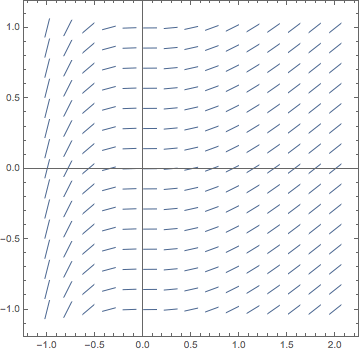Slope Fields with Mathematica - Exercise 1.4
Making Slope Fields by Yourself
A Post Exercise Discussion of
dy/dx = x2 e-x, on the region -1 ≤ x ≤ 2, and -1 ≤ y ≤ 1
Don't cheat! If you didn't do the exercise in Mathematica before you came here to see the discussion, go back and do it now!
Assuming that you did the exercise correctly, you should have produced a picture that was similar to the following:

Here too, you should have noticed that the isoclines for the slope field are vertical lines, (just like the last three examples.) Do you recognize the general trend of the field this time? No? Well don't feel bad--neither do I. It would be too much to expect that every slope field generated by a differential equation would remind us of something on our little mental list of common functions. This fact doesn't make the slope field any less useful as a way of analyzing the general behavior of the solutions of a differential equation.
This differential equation can once again be solved by direct integration, though the integral is not a particularly simple one. (It requires integration by parts applied twice, or tabular integration.) The result of integrating:
is the function:
We could use a graphing program on the computer, or even a graphing calculator, to get a few sample curves from the family of solutions we just found. We could even use the analysis techniques we learned in calculus to determine the behavior of these curves. However, such analysis isn't that important to us at this point. After all, we're soon going to encounter differential equations which cannot be integrated directly as we've managed to do so far. In order to be able to handle this broader class of equations we'll have to develop ways of looking for solutions in slope fields based solely on the picture of the slope field itself. These tricks will be revealed in the next laboratory project.
We're done with the discussion of this problem, so let's go back to the exercises.







